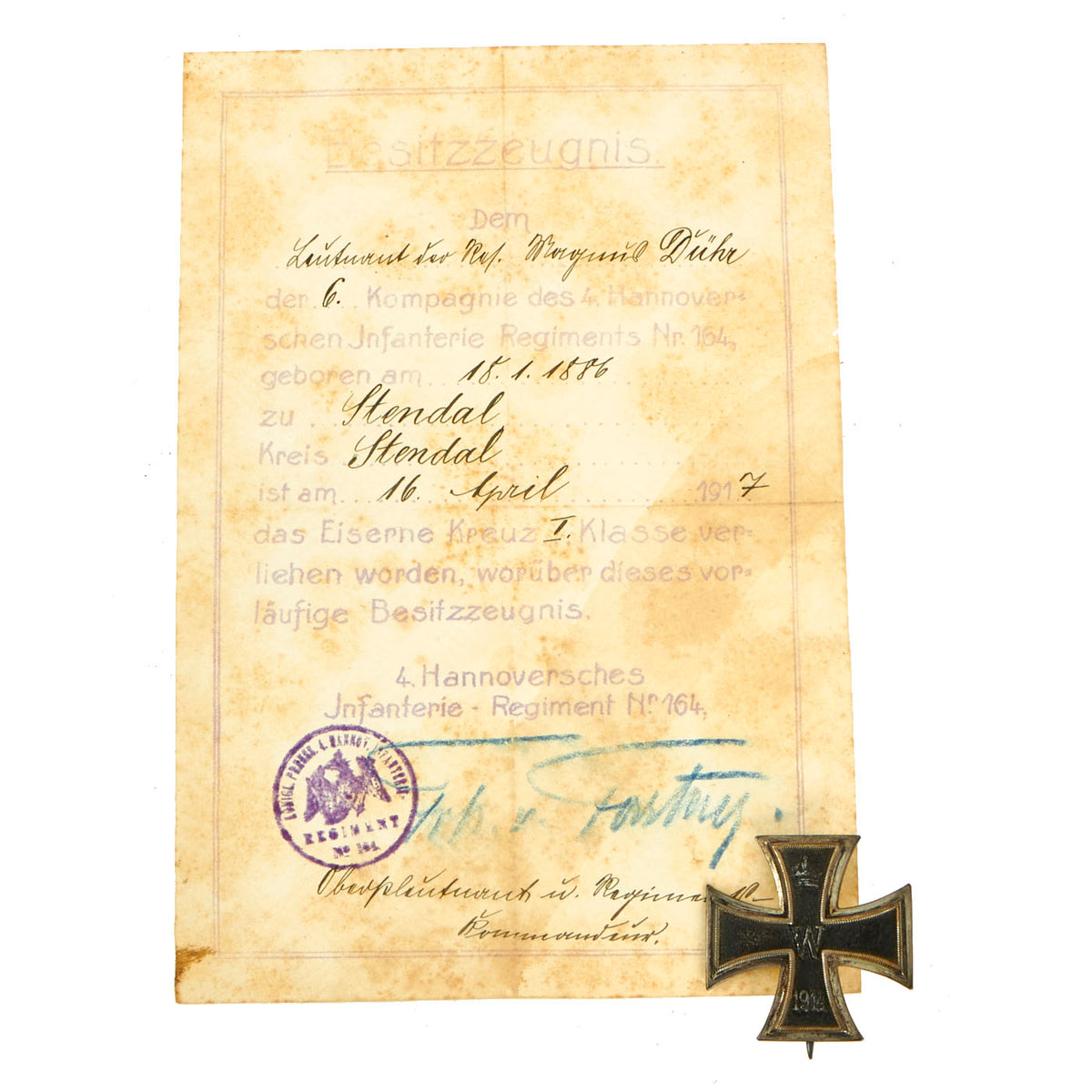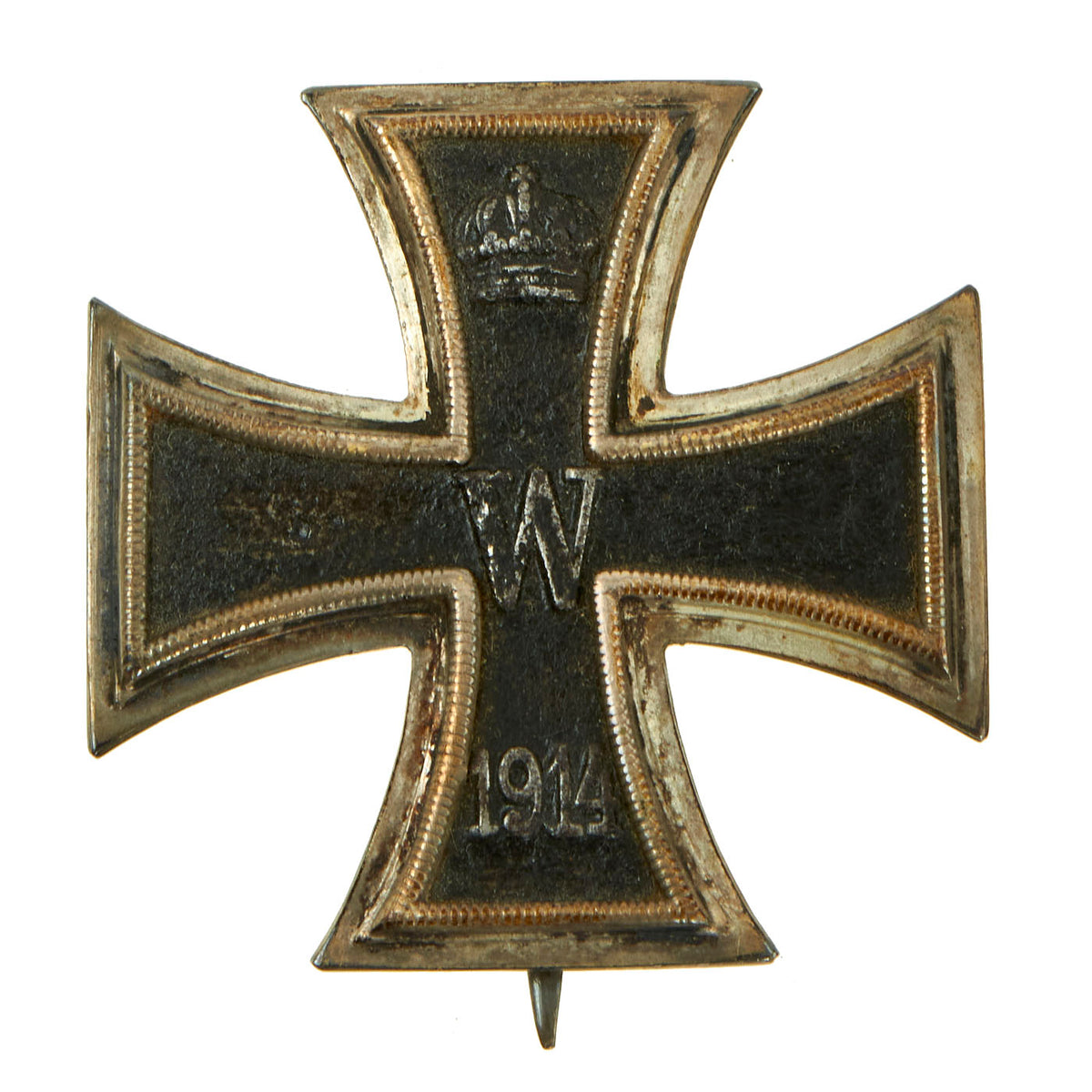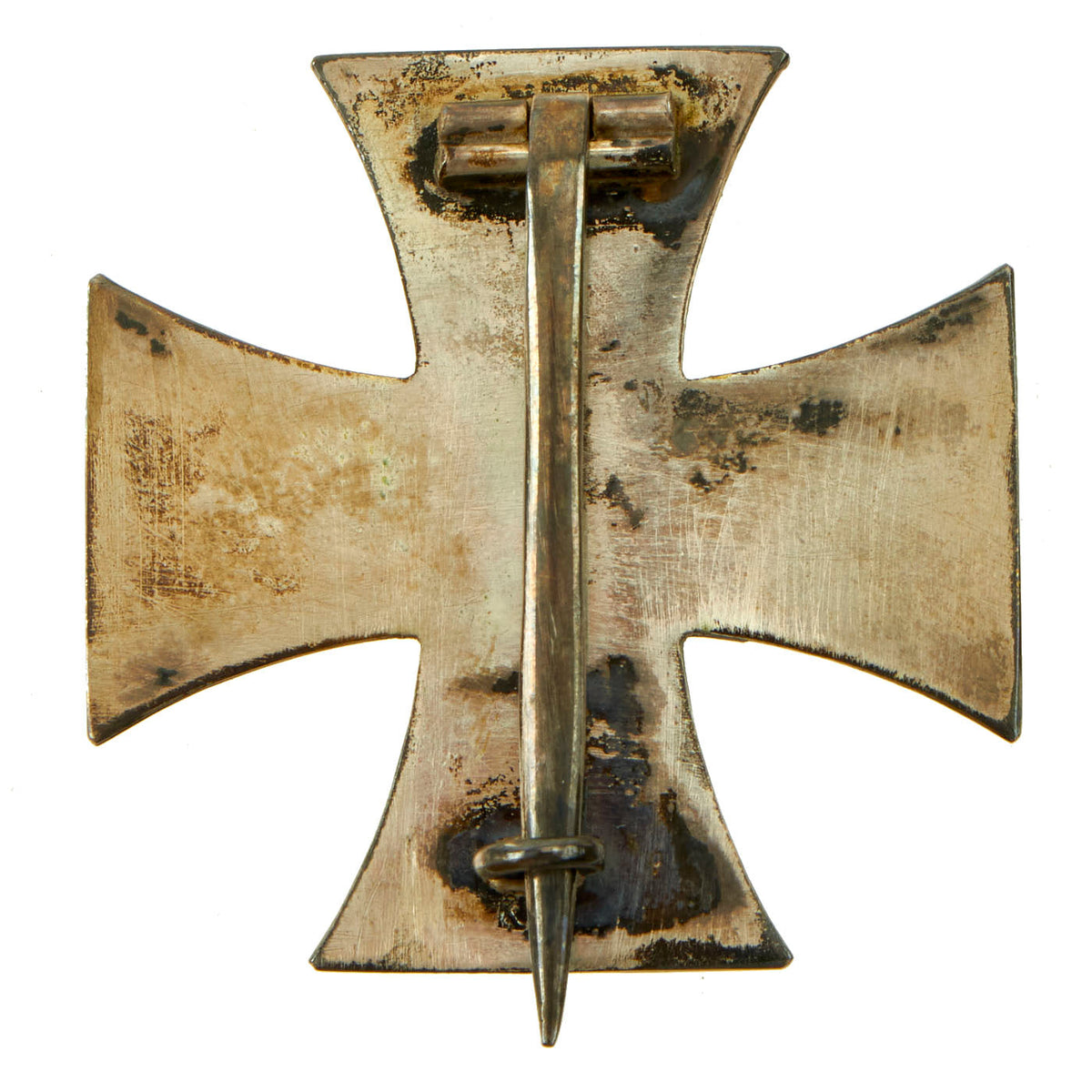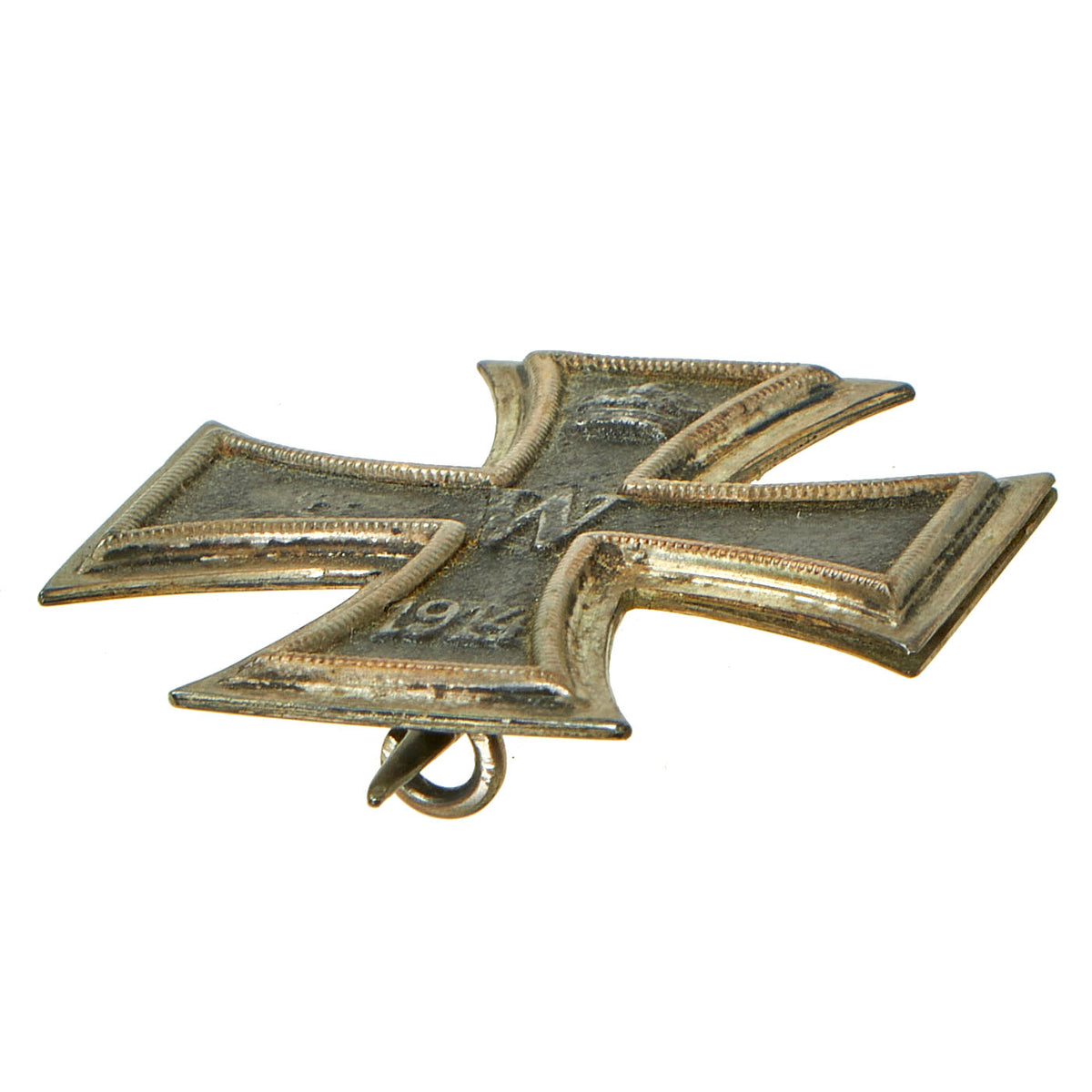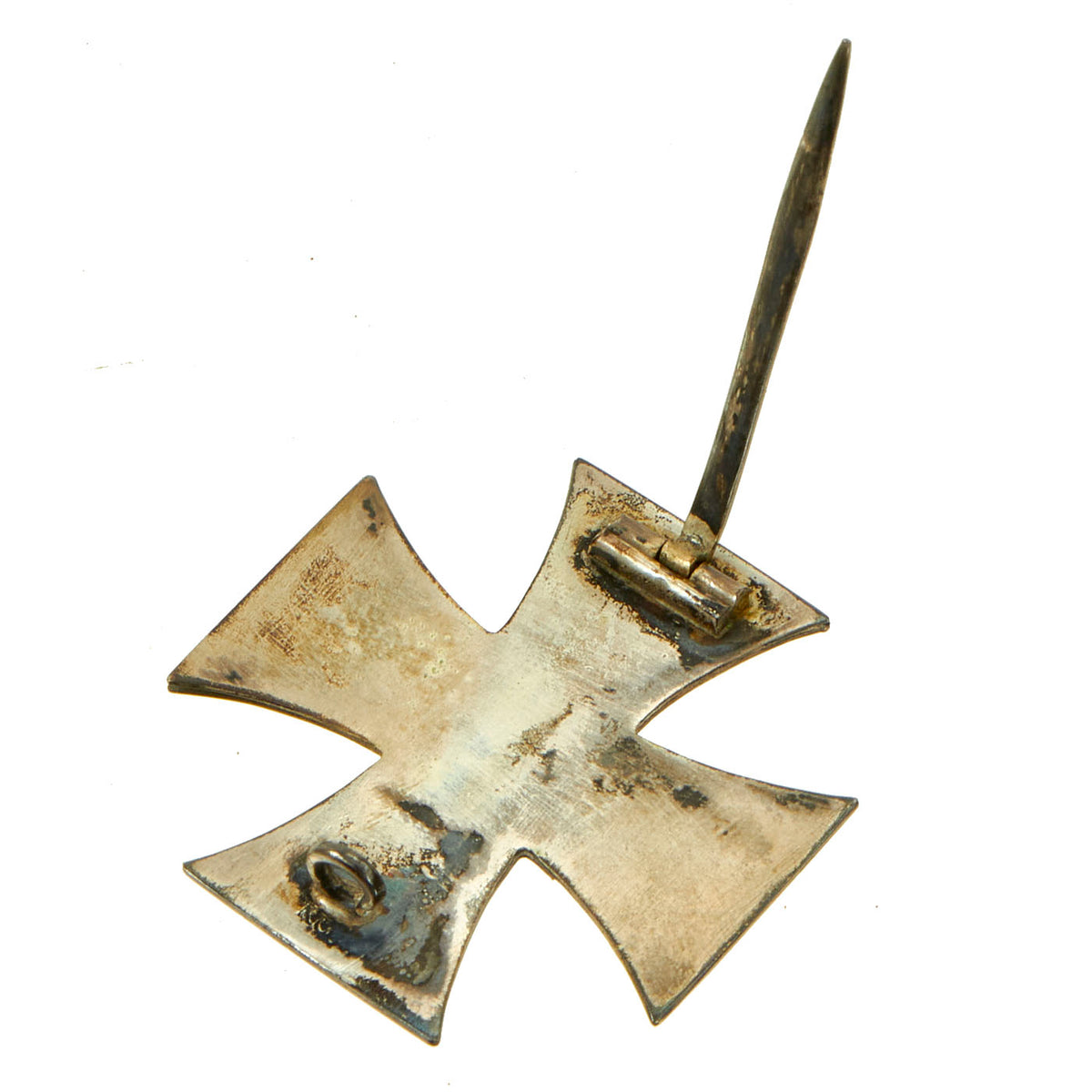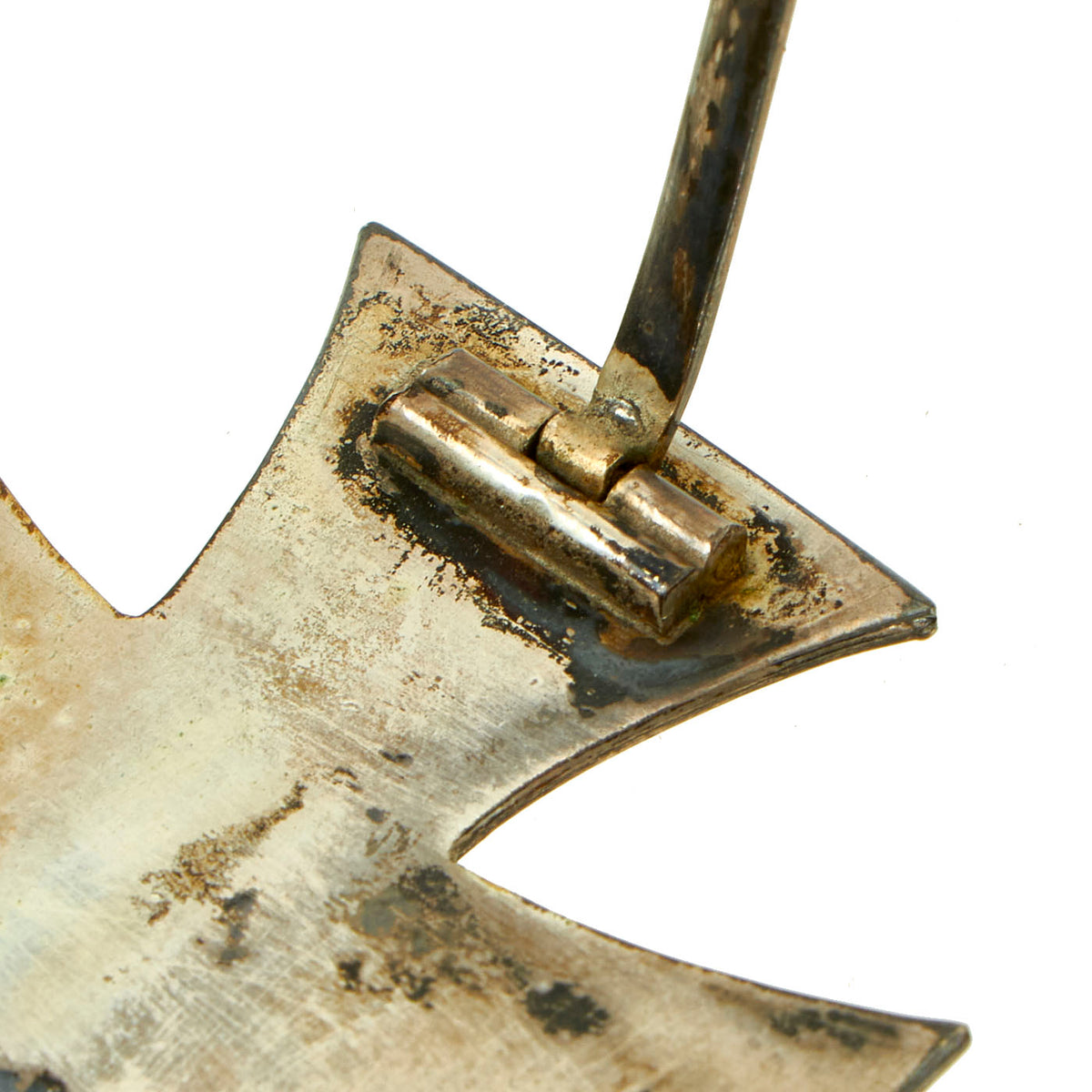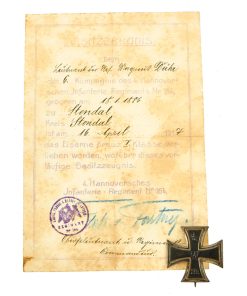Original German WWI Imperial German 164th (4th Hannover) Infantry Regiment Leutnant 1st Class Iron Cross by the Royal Mint With Award Document Original Items
$ 495,00 $ 148,50
Original Item: Only One Available. Established by Frederick William in 1813 for gallantry in action, the decoration was revived several times for later conflicts. The bulk of the issues are divided into 1st and 2nd class versions, but a rare and superior ‘Grand Cross’ was also awarded for successful field commanders. During WW1 the lower decoration was freely awarded with 5½ million second class types issued. Originally, the Iron Cross was an award of the Kingdom of Prussia, however given Prussia’s pre-eminent place in the German Empire formed in 1871, it became an award for all of Germany.
The basic design of the WW1 crosses is a central cross pattée struck from iron and mounted in a silver frame which has a raised crenulated decorative border. The obverse of the cross bears the date 1914 under a crowned W monogram. Second class crosses would have a ring at the top where a ring was attached, and had more markings on the back. The first class award, however, was meant to attach directly to the front of the uniform, and this example has a double barrel hinge, a soldered catch, and a securing pin. This pin is quite long, extending past the end of the cross. The lower leg of the cross is stamped KO, which signifies it was made by Königliches Münzamt Orden (the Royal Mint Order), in Berlin.
Condition of the award is very good, with much of the original silver still bright, with only light tarnishing. The enamel on the central cross is very well retained, with just a bit of wear through on the raised portions of the award.
Please note the edge seam for authentication, which is not present on reproductions. Iron crosses were commonly constructed from an iron core sandwiched in a surrounding two part silver frame, normally the seam of these two silver parts is visible around the edge of the cross as is seen on this fine example. This example is a “flat’ style Iron Cross. Others could be quite “Vaulted” in shape. The silver has a great aged patina, and the painted central area is still clear.
The award document has handwriting which is difficult to read, but we have been able to make out a few important details. This was awarded to a Leutnant in Company 6 of the 164th (4th Hannover) Infantry Regiment on April 16,1917. We cannot make out the full name of the recipient, but we can make out the last name which is Dühn. The document measures 8 ½” x 6” and is in a small document sleeve.
This is a fantastic chance to own a solid period example of the most iconic of all Imperial German awards.
Emperor Wilhelm II reauthorized the Iron Cross on 5 August 1914, at the start of World War I. During these three periods, the Iron Cross was an award of the Kingdom of Prussia, although—given Prussia’s pre-eminent place in the German Empire formed in 1871—it tended to be treated as a generic German decoration. The 1813, 1870, and 1914 Iron Crosses had three grades:
Iron Cross 2nd Class (Eisernes Kreuz 2. Klasse, or EKII)
Iron Cross 1st Class (Eisernes Kreuz 1. Klasse, or EKI)
Grand Cross of the Iron Cross (Großkreuz des Eisernen Kreuzes, often simply Großkreuz)
Although the obverse of the medals of each class was identical, the manner in which each was worn differed. The Iron Cross 1st Class employed a pin or screw posts on the back of the medal, and was worn on the left side of the recipient’s uniform, like the original 1813 version. The Iron Cross 2nd Class, and the larger Grand Cross, were suspended from different ribbons: the Grand Cross from a neck ribbon, the 2nd Class from a ribbon on the chest. The usual display of the 2nd Class version was as a ribbon through one of the button holes in the recipient’s tunic.
The Grand Cross was intended for senior generals of the Prussian or (later) the German Army. An even higher decoration, the Star of the Grand Cross of the Iron Cross (also called the Blücher Star), was awarded only twice, to Generalfeldmarschall Gebhard Leberecht von Blücher in 1813 and to Generalfeldmarschall Paul von Hindenburg in 1918. A third award was planned for the most successful German general during World War II, but was not made after the defeat of Germany in 1945.
The Iron Cross 1st Class and the Iron Cross 2nd Class were awarded without regard to rank. One had to possess the 2nd Class already in order to receive the 1st Class (though in some cases both could be awarded simultaneously). The egalitarian nature of this award contrasted with those of most other German states (and indeed of many other European monarchies), where military decorations were awarded based on the rank of the recipient. For example, Bavarian officers received various grades of that Kingdom’s Military Merit Order (Militär-Verdienstorden), while enlisted men received various grades of the Military Merit Cross (Militär-Verdienstkreuz). Prussia did have other orders and medals which it awarded on the basis of rank, and even though the Iron Cross was intended to be awarded without regard to rank, officers and NCOs were more likely to receive it than junior enlisted soldiers.
During World War I, approximately 218,000 EKIs, 5,196,000 EKIIs and 13,000 non-combatant EKIIs were awarded. Exact numbers of awards are not known, since the Prussian military archives were destroyed during World War II. The multitude of awards reduced the status and reputation of the decoration. Among the holders of the 1914 Iron Cross 2nd Class and 1st Class was Adolf AH, who served as an Austrian citizen in the Bavarian Army with the rank of Gefreiter (lance-corporal), he received these medals for showing bravery on the field of battle. Most photographs of AH show him wearing his EKI in standard fashion on his left breast.
Fast Shipping with Professional Packaging
Thanks to our longstanding association with UPS FedEx DHL, and other major international carriers, we are able to provide a range of shipping options. Our warehouse staff is expertly trained and will wrap your products according to our exact and precise specifications. Prior to shipping, your goods will be thoroughly examined and securely secured. We ship to thousands clients each day across multiple countries. This shows how we're dedicated to be the largest retailer on the internet. Warehouses and distribution centres can be located throughout Europe as well as the USA.
Note: Orders with more than one item will be assigned a processing date depending on the item.
Before shipping before shipping, we'll conduct a thorough inspection of the items you have ordered. Today, the majority of orders will be delivered within 48 hours. The delivery time will be between 3-7 days.
Returns
The stock is dynamic and we cannot completely manage it because multiple stakeholders are involved, including our factory and warehouse. So the actual stock may alter at any time. It's possible that you may not receive your order once the order has been made.
Our policy is valid for a period of 30 days. If you don't receive the product within 30 days, we are not able to issue a refund or an exchange.
You can only return an item if it is unused and in the same state as the day you received it. You must have the item in its original packaging.
Related products
Uncategorized
Uncategorized
Uncategorized
Uncategorized
Uncategorized
Uncategorized
Uncategorized
Angolan Rebel 1970s era 60mm Inert Display Mortar from Angolan Civil War Original Items
Uncategorized
Uncategorized
Uncategorized
Uncategorized
Uncategorized
Uncategorized
Armoured Fighting Vehicles of the World: AFVs of World War One (Hardcover Book) New Made Items
Uncategorized
Uncategorized
Uncategorized
